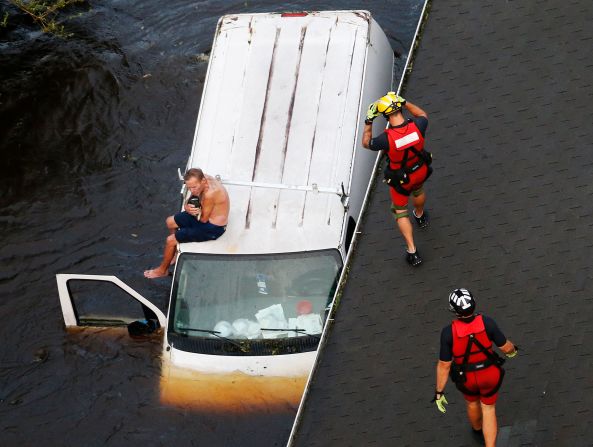Editor’s Note: Adam Sobel, a professor at Columbia University’s Lamont-Doherty Earth Observatory and Fu Foundation School of Engineering and Applied Science, is an atmospheric scientist who studies extreme events and the risks they pose to human society. Sobel is the author of “Storm Surge,” a book about Superstorm Sandy. Follow him on Twitter: @profadamsobel. Sean Solomon is the director of Columbia University’s Lamont-Doherty Earth Observatory and a winner of the National Medal of Science. The opinions expressed in this commentary are solely those of the authors. View more opinion on CNN.
As we write, Florence is slamming into the Carolinas. State, local and federal emergency planners have been working around the clock for the past week to prepare their communities and citizens to deal with this powerful storm.
The governors of North and South Carolina and the mayors of Wilmington and Myrtle Beach told their citizens and tourists along the coasts to evacuate to higher ground in advance of the flooding and storm surge. Nearly 2 million people were under mandatory and voluntary evacuations orders.
The National Guard and the Coast Guard have been providing search and rescue services. And the media, both traditional and social, are broadcasting non-stop real-time updates as the storm blankets the coast. All of this advance planning was possible because the science and technology that goes into predicting hurricanes have gotten steadily better for decades. We now have much better forecasts than we used to, available further in advance.
Better forecasts give local officials more timely information, allowing them and their citizens to make life-saving decisions. If Florence had hit the Carolinas 30 years ago, the accuracy of the track forecast two days ahead of time would have been about the same as that for the five-day forecast today. Whatever the final death toll from Florence, it would almost certainly have been substantially larger back then, even though there are many more people living in the areas at risk today.
In pictures: Hurricane Florence and its aftermath
How did we get forecasts good enough to give us a week to prepare for storms such as Florence? It may feel like they are free, because as individuals we don’t see a bill for them. But they aren’t free. They are the result of sustained public investment in scientific research and education.
According to the American Association for the Advancement of Science, in inflation-adjusted dollars, federal support for university-based research increased from around $8 billion per year in the 1960s to more than $30 billion today.
Federal agencies have long supported basic research in mathematics and the physical sciences, computer science and engineering, and the geosciences. That basic research forms the foundation that enables the development of sophisticated models that can simulate the atmosphere with amazing fidelity.
Key components of that foundation today include the powerful supercomputers needed to run the models; satellites, radar, and other instruments carried on airplanes, balloons and other platforms that make the key observations the models need to start their predictions; and, equally important, an understanding of how the atmosphere and ocean work, separately and together.
For example, beginning with Ed Lorenz’s work on chaos theory in the 1960s, scientists have worked out how and why the weather is unpredictable beyond a week or two ahead of time. This understanding informs the data assimilation systems used to put observations into the prediction models, and the ensemble systems that run the same model over and over again to assess uncertainty, producing the “spaghetti diagrams” of multiple hurricane tracks that you can now find all over the internet when a storm is coming.
At our own Lamont-Doherty Earth Observatory, in the 1980s, Mark Cane and Steven Zebiak developed the first computer model capable of predicting El Nino events, and this led to the seasonal forecasts of climate variations – including overall levels of hurricane activity, though not specific individual hurricanes – that we now get months in advance.
All of these products of publicly funded research allow us to predict our weather and climate with the accuracy needed to save lives in the ways we are seeing now. The observations, models and computers – all implemented by well-trained professionals who themselves are products of sustained public investments in education and training that have been made alongside the investments in research – turn huge amounts of raw data into “actionable intelligence” to be used by businesses, local and state governments, and citizens.
Florence is a dangerous storm. It may devastate coastal communities and the barrier islands with wind, rain and storm surge. There have already been fatalities, and most likely, there will be more, and those deaths will be very visible in the media.
Of course, any number of deaths is tragic. But the good news – though much less visible – will be the much greater number of lives that have been saved by this nation’s continuing investment in the underlying science and technology.









































































